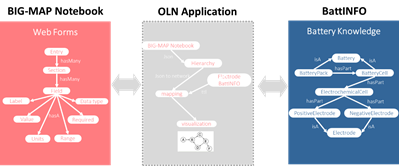BIG-MAP has developed an online laboratory notebook to securely store electrochemical and characterizations data using standards and protocols necessary to ensure reproducibility of battery testing and sharing. Metadata necessary to describe cell chemistry and components as well as cycling protocols are collected, and linked to the BattINFO Ontology entries. Demonstration is made that a web-based interface, the notebook, can be successfully linked to the ontology BattINFO.
Two complementary tools have been developed in the BIG-MAP projects: first, the ontology BattINFO that provides a shared vocabulary and taxonomy defining properties, relationships of battery-related concepts; and secondly, the BIG-MAP notebook that ensures standardized collection, reporting, documentation and storage of the collected research data following BIG-MAP standards and protocols. The two tools shall avoid usual battery pitfalls regarding the lack of reporting of information necessary to reproduce data and facilitate data exchange.1
The two tools differ both in their nature and goals, with a philosophical discrepancy between a web-based software developed to ensure proper collection of data (the Notebook), and a taxonomy developed to provide relationship between battery-related concepts (BattINFO). As in any system of this kind, degeneracy will develop over time leading to a lack of one-to-one correspondence between metadata included into the BIG-MAP notebook and BattINFO.

To fully integrate the Notebook into the BIG-MAP architecture, and demonstrate that BattINFO can serve as the central vocabulary ensuring automatic search of battery concepts, an application ontology has been developed. For this, a mapping is made between the BIG-MAP Notebook entries and concepts as listed in BattINFO, providing the lacking relationships between metadata reported by users to ensure consistent comparison and interpretation using BattINFO. Concepts lacking in BattINFO are mapped and stored in the application ontology, helping further development of BattINFO. Overall, creating this link demonstrates how the logic developed in BattINFO can be used to interface a web-based software with automated tools necessary for the deployment of machine learning algorithms.
The impact of such a notebook goes beyond the BIG-MAP project as it now serves as a template to share electrochemical data across different BATTERY 2030+ projects and eventually it will be open for the entire battery community.
1 El Bousiydy, H., Lombardo, T., Primo, E., Dusquenoy, M., Morcrette, M. Johansson, P. Simon, P., Grimaud, A. and Franco, A.A., What can text mining tell us about Li-ion battery researchers’ habits?, Batteries & Supercaps, 2021, 4, 758-766. https://doi.org/10.1002/batt.202000288